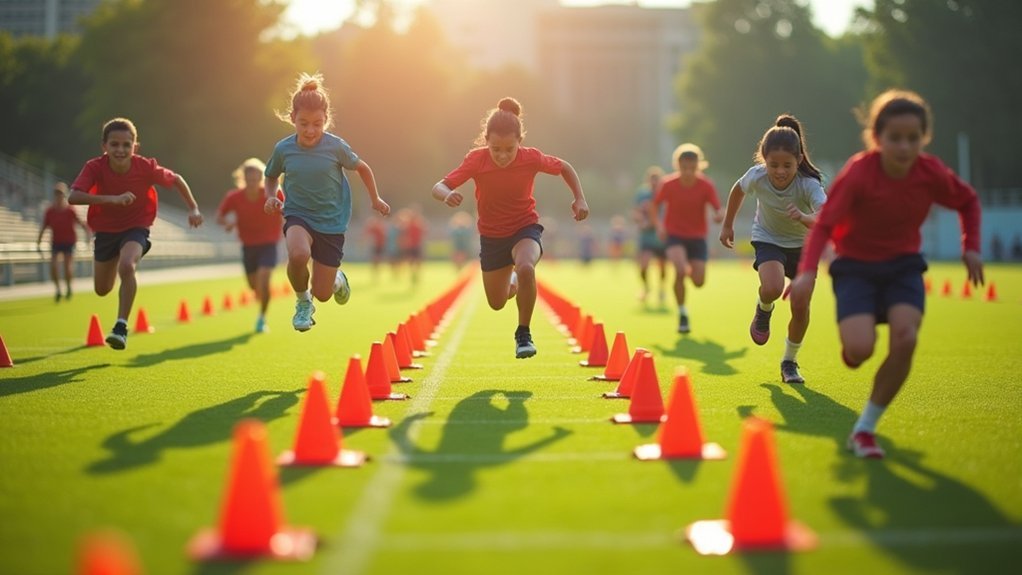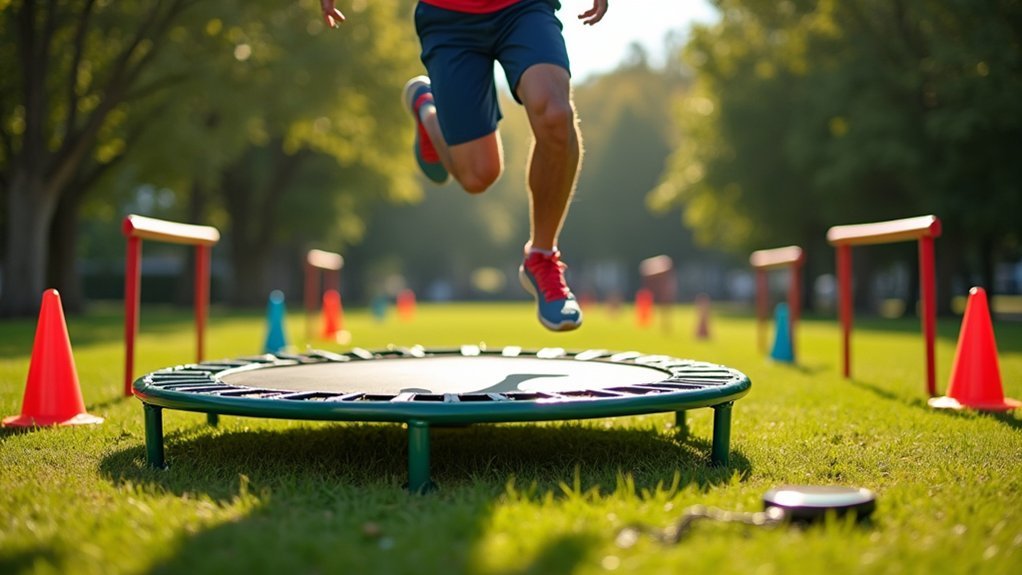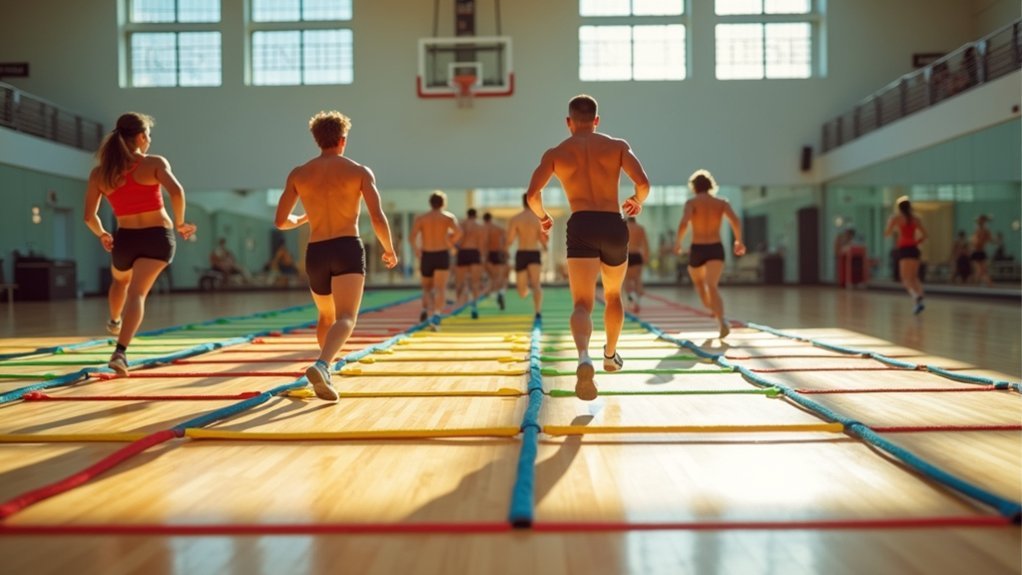Trampoline-based agility circuits offer the most effective coordination training by challenging your vestibular system, proprioception, and neuromuscular control simultaneously. You’ll see faster results by progressively increasing complexity—starting with two-footed bounces before advancing to single-leg exercises, multi-directional jumps, and aerial balance drills. For maximum benefit, incorporate rhythmic synchronization and progressive overload techniques like increased jump height and movement variations. The neurological adaptations you’ll develop transfer directly to improved performance in competitive settings.
What Agility Circuits Maximize Coordination Skills?

While many athletes focus solely on strength or endurance training, developing coordination through specialized agility circuits can dramatically enhance your overall athletic performance.
Ladder drills and cone weaving are particularly effective agility drills that require precise foot placement and rapid directional changes.
You’ll see significant coordination improvements by incorporating shuttle runs into your routine, as they force you to adjust movements while sprinting and changing directions.
Dot drills effectively boost foot speed and coordination through jumping patterns that engage multiple muscle groups and strengthen your mind-body connection.
For maximum benefit, try circuit training that combines lateral plyometric jumps with high-knee runs. This challenges your coordination by demanding explosive movements while maintaining balance.
Dynamic obstacle courses with running, jumping, and weaving movements provide an enjoyable way to develop these essential skills.
The Science Behind Trampoline-Based Coordination Training
Trampolines activate your vestibular system with each bounce, sending rapid signals to your brain that improve spatial awareness and balance control.
Your body develops refined motor patterns as you adapt to the unstable surface, strengthening neural connections between your cerebellum and muscle groups.
You’ll notice these improvements transfer to everyday movements, as trampoline training creates lasting changes in how your brain processes and responds to coordination challenges.
Vestibular System Activation
Although often overlooked, the vestibular system acts as your body’s internal GPS, constantly monitoring position, movement, and spatial orientation.
By incorporating trampoline exercises into your agility circuits, you’re directly stimulating this essential system, enhancing your coordination skills and athletic performance.
- Each bounce challenges your body to maintain balance while in motion
- Your proprioceptive awareness improves as you adapt to the unstable surface
- Neural pathways responsible for coordination become more efficient with regular practice
- Your reaction time decreases as your vestibular system processes spatial information faster
- Complex movement patterns on trampolines create stronger connections between your brain and muscles
When you train on a trampoline, you’re not just having fun—you’re rewiring your brain for better balance, agility, and coordination in all your athletic endeavors.
Motor Pattern Development
Neuroscience reveals why trampoline training dramatically enhances your motor patterns. Each bounce creates repetitive neuromuscular connections that strengthen your brain’s movement pathways, ultimately leading to improved body awareness and spatial orientation during athletic activities.
When you utilize a trampoline, you’re simultaneously engaging multiple muscle groups while adapting to changing gravitational forces. This dynamic environment stimulates your proprioception—your body’s position-sensing ability—which is essential to improve your balance and coordination in sports.
You’ll develop quick reaction times as you practice rapid changes in direction on the unstable surface.
Research confirms that consistent trampoline exercises lead to measurable coordination improvements, with athletes reporting greater movement confidence. The motor pattern development achieved through trampoline training creates neural adaptations that transfer effectively to your sport-specific movements.
Essential Mini Trampoline Agility Circuit Components

To maximize your coordination gains, you’ll need to incorporate diverse bounce pattern variations that challenge your body to adapt to changing movement demands.
You can start with simple two-footed bounces before progressing to more complex patterns like lateral jumps, figure eights, and directional changes mid-bounce.
The key to effective stability challenge progression lies in gradually reducing your base of support—moving from wide-stance jumps to narrow-stance, then to single-leg exercises—as your proprioceptive abilities improve.
Bounce Pattern Variations
When athletes master the fundamental mini trampoline bounce, they’re ready to explore numerous pattern variations that greatly enhance coordination development.
You’ll find that incorporating diverse bounce patterns challenges your body to make split-second balance adjustments, markedly improving your coordination skills. Lateral movements on the trampoline will boost your agility by training directional changes essential for athletic performance.
- Try alternating between single-leg hops and double-leg bounces for increased circuit complexity
- Incorporate side-to-side jumps to develop multi-directional agility
- Sync your movements with rhythmic timing or music to enhance body awareness
- Practice sequential patterns that require memory and execution precision
- Gradually increase complexity by combining different movement patterns into fluid sequences
With consistent practice, these bounce pattern variations will transform your stability, balance, and overall coordination capabilities.
Stability Challenge Progression
Progressive stability challenges form the cornerstone of effective mini trampoline training, pushing your coordination skills to new heights while minimizing joint impact.
Begin with simple bounce-and-hold exercises that develop proprioception and spatial awareness essential for agility. As you master basic stabilization, introduce varying heights and angles to your routine.
These adjustments force your core muscles to engage differently, promoting adaptation and enhanced coordination. You’ll notice improvements in your ability to control movements with precision.
For advanced development, incorporate lateral movements and directional changes into your agility circuits.
These variations train your body to respond quickly to shifting demands, building the reflexes needed for sports performance. The low-impact nature of mini trampoline work allows you to challenge yourself repeatedly without risking overuse injuries.
Beginner Rebounding Sequences for Foundational Coordination
Beginner rebounding sequences form the cornerstone of foundational coordination skills, much like building blocks create a sturdy structure. When you practice these agility training exercises twice weekly, you’ll develop muscle memory essential for advanced movements.
Mastering simple bounce patterns builds the neural pathways your body needs for complex rebounding movements later on.
Incorporate drills like high knees and lateral shuffles to enhance foot coordination and body awareness while changing direction on the rebound surface.
- Add colored cones as visual cues to improve spatial awareness
- Practice maintaining balance during direction changes for better body control
- Utilize mini hurdles to challenge your coordination patterns
- Implement step-in drills for precise foot placement
- Try agility ladder sequences on the rebounder for improved responsiveness
These foundational sequences will transform your ability to shift between movements efficiently while maintaining control.
Advanced Trampoline Movement Patterns for Elite Athletes

To master aerial balance drills, you’ll need to practice controlling your center of gravity while executing complex airborne maneuvers like double front flips and corkscrews.
Rotational control sequences build upon this foundation by challenging you to maintain precise body positioning throughout multiple twists and somersaults.
These advanced movement patterns will dramatically improve your spatial awareness and execution quality, giving you the competitive edge essential for elite trampoline performance.
Aerial Balance Drills
Elite athletes seeking to master aerial control can transform their performance through advanced trampoline movement patterns.
You’ll develop essential spatial awareness and core stability while practicing precise timing for competitive applications in gymnastics and diving.
These coordination-focused drills challenge your body’s ability to execute complex movements while airborne.
- Incorporate twisting and flipping techniques to enhance your aerial agility
- Progress gradually by adding multiple rotations at varying heights
- Focus on body positioning awareness during each aerial maneuver
- Practice consistent timing to translate skills to competitive performance
- Use these drills to improve quick directional changes in your primary sport
Rotational Control Sequences
While mastering basic aerial maneuvers builds a foundation, rotational control sequences take your trampoline training to elite levels by challenging your body’s three-dimensional awareness.
Incorporate full twists and back flips into your agility circuits to develop precise timing and spatial orientation needed for competitive performance.
You’ll maximize coordination skills by practicing these rotational patterns at varying heights and speeds, training your body to make real-time adjustments during execution.
This enhanced proprioception directly translates to performance improvement in competition settings.
Multi-Directional Rebounding Drills to Enhance Spatial Awareness
The brain’s ability to process and react to environmental stimuli stands as a cornerstone of athletic performance, making multi-directional rebounding drills invaluable for developing spatial awareness.
You’ll enhance your coordination by incorporating lateral shuffles, diagonal sprints, and backward runs that engage multiple muscle groups simultaneously.
Add equipment like rebounders or elastic bands to increase the challenge and force your body to adapt to shifting demands.
With regular practice, you’ll notice improved response times and decision-making in fast-paced scenarios.
- Trains your brain to process varying stimuli rapidly
- Improves positioning relative to teammates and opponents
- Enhances agility through multi-angle movement patterns
- Develops better balance during quick directional changes
- Builds sport-specific spatial awareness for competitive advantage
Rhythm-Based Trampoline Circuits for Timing Precision
Synchronizing your body’s movements with external rhythms creates a powerful foundation for athletic timing precision, which is why rhythm-based trampoline circuits have become essential training tools for serious athletes. By performing 180-degree turns and lateral hops in time with music, you’ll develop muscle memory that translates directly to improved coordination in competitive situations.
| Circuit Type | Primary Benefit | Training Focus |
|---|---|---|
| Beat-Matched Jumps | Timing precision | Neural pathway development |
| Target Landing Sequences | Spatial awareness | Coordination under pressure |
| Rhythmic Direction Changes | Quick shifts | Agility enhancement |
These structured circuits stimulate neural pathways associated with motor skills, enhancing your reaction time and agility. You’ll notice significant improvements in sports requiring quick directional changes as your body learns to automatically coordinate movements with precise timing.
Combining Upper and Lower Body Movements on Mini Trampolines
Integrating upper and lower body movements on mini trampolines creates a powerful coordination challenge that dramatically enhances your athletic capabilities.
Synchronize your entire body on mini trampolines to unlock superior coordination and athletic performance.
This low-impact method of agility training stimulates neuromuscular coordination while protecting your joints. You’ll develop quicker reaction times and improved proprioception as you master these combined movements.
- Try jumping jacks while bouncing to simultaneously improve balance and cardiovascular fitness
- Incorporate arm punches during basic jumps to strengthen coordination between limbs
- Add overhead reaches to your bouncing routine to challenge your core stability
- Practice multi-directional movements to develop extensive coordination skills
- Maintain consistent practice to build muscle memory that transfers to your sport performance
Regular practice on mini trampolines creates neural pathways that enhance your overall coordination skills, making complex athletic movements feel more natural and effortless.
Progressive Overload Techniques for Trampoline Agility Circuits
Five essential progressive overload techniques can transform your trampoline agility training from basic to advanced.
Start by gradually increasing your jump height to enhance power and coordination as your body adapts to greater demands.
Next, incorporate movement variations like twists and turns to engage stabilizing muscles, dramatically improving overall agility.
You’ll also benefit from extending session duration over time, which builds endurance while reinforcing coordination patterns during longer activities.
Implement interval training by alternating between high-intensity jumps and strategic rest periods to develop speed and quick reaction times.
Finally, challenge yourself with resistance tools such as weighted vests or bands during your agility exercises.
These tools promote strength gains that directly translate to improved coordination and performance in your trampoline circuits.
Sport-Specific Rebounding Exercises for Transfer of Skills
When athletes master sport-specific rebounding exercises, they develop transferable skills that dramatically improve their performance across various sporting contexts.
Incorporating agility ladder drills with rebounding movements enhances your lateral quickness and foot speed, vital elements for effective gameplay.
- Box jumps combined with lateral shuffles build explosive speed while simulating real game movements.
- Wall or partner rebounding drills sharpen your hand-eye coordination and timing.
- Cone-based agility circuits improve reaction time and direction changes essential for rebounding.
- Plyometric exercises like tuck jumps develop the leg power needed for effective rebounds.
- Sport-specific rebounding exercises create muscle memory that transfers directly to competition.
Measuring Coordination Improvements From Trampoline Training
Tracking your coordination progress through trampoline training requires both objective metrics and subjective awareness of your body’s adaptations.
You’ll notice improvements in how quickly you can shift between movements and maintain balance during complex sequences.
Measure your coordination gains through timed agility drills before and after several weeks of trampoline exercises. Research confirms these improvements transfer to other activities, with participants showing enhanced reaction times and spatial orientation across various physical tasks.
Document your progress by recording how many sequential movements you can perform without losing rhythm.
You’ll likely see measurable improvements in your ability to control simultaneous body movements as your proprioceptive pathways strengthen. This enhanced coordination builds a foundation for better performance in sports requiring quick directional changes and precise body control.
Frequently Asked Questions
How Does Agility Training Improve Coordination?
Agility training improves your coordination by developing neural pathways that control muscle movements. You’ll enhance reaction times, spatial awareness, and body control as you practice quick directional changes and rhythmic movements with different muscle groups.
What Are the Three Types of Agility?
You’ll encounter three types of agility in your training: reactive agility (responding to unexpected stimuli), proactive agility (anticipating movements), and dynamic agility (maintaining control while changing direction). Each develops different coordination aspects.
What Activity Improves Agility?
You’ll improve agility through ladder drills, cone exercises, shuttle runs, side shuffles, and plyometric jumps. Dot drills also enhance coordination by challenging you to maintain control while changing directions quickly during timed intervals.
What Are the 3 Main Components of Agility?
You’ll need to focus on the three main components of agility: speed, balance, and coordination. These elements work together, allowing you to change direction quickly and efficiently while maintaining control of your movements.
In Summary
You’ve now got everything you need to revolutionize your coordination training with mini trampoline circuits. Start with foundational rebounding exercises and gradually progress to sport-specific patterns that challenge your neuromuscular system. By consistently incorporating these dynamic sequences, you’ll develop superior spatial awareness, reaction time, and multi-limb coordination. Track your improvements regularly and you’ll see measurable gains transferring directly to your athletic performance.





Leave a Reply